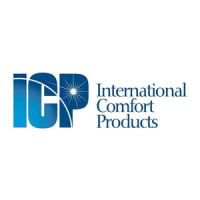
Do you have a question about the ICP DLC4HV18K1A and is the answer not in the manual?
| Brand | ICP |
|---|---|
| Model | DLC4HV18K1A |
| Category | Air Conditioner |
| Language | English |
Provides necessary information for servicing, repair, and maintenance of the DLF4(A,H) and DLC4(A/H) units.
Details essential safety precautions for installing, servicing, and operating HVAC equipment.
Warning about severe injury or death from electrical shock.
Caution to prevent equipment damage or improper operation from unsafe practices.
Covers voltage, capacity, air volume, and efficiency ratings for indoor units.
Details compressor, heat exchanger, fan, refrigerant, and operating parameters for outdoor units.
Explains the meaning of each position in the model number for unit identification.
Details the structure and meaning of serial number positions for unit identification.
Lists standard features like ease of operation, comfort, safety, and reliability functions.
Details optional accessories, warranty periods, and extended warranty information.
Provides detailed width, height, and depth measurements for indoor units.
Details dimensions for outdoor units across various sizes (09K to 36K).
Specifies minimum clearance distances around the indoor unit for proper installation.
Details required clearances around the outdoor unit for proper operation and maintenance.
Illustrates cooling and heating operating limits based on indoor and outdoor temperatures.
Provides charts defining operating limits for different unit sizes and voltages.
Presents detailed electrical specifications for outdoor and indoor units, including voltage, current, and power.
Offers guidelines for connecting power and communication wires, including AWG size and length.
Illustrates wiring connections for 115V units, showing terminal blocks and power supply.
Depicts wiring for 208/230V units, detailing connections between indoor and outdoor units.
Shows electrical wiring schematics for various indoor unit models and voltages.
Provides detailed wiring diagrams for outdoor units across different models and power supplies.
Illustrates the refrigerant path for cooling-only models, showing key components and valves.
Depicts the refrigerant flow for cooling and heating models, including 4-way valve operation.
Details pipe routing options, hole sizes, and general installation guidelines for refrigerant lines.
Specifies refrigerant charge amounts and maximum allowable piping lengths for different unit sizes.
Explains recommended methods for evacuating the system to remove air and moisture.
Details vacuum depth measurement and final checks for tubing integrity and connections.
Identifies and explains the function of each button on the remote control for different unit sizes.
Describes the various symbols and indicators displayed on the remote control screen.
Provides instructions for installing batteries and important notes regarding remote control maintenance.
Explains temperature parameters, basic operational functions, and cooling mode processes.
Details various protection mechanisms and error codes displayed for malfunctions.
Covers drying function, memory, sensor error detection, and compressor protection features.
Provides essential safety precautions and general checks before performing troubleshooting.
Lists error codes, their corresponding symptoms, and potential causes for various unit models.
Guides through troubleshooting common issues like no power or controller malfunctions.
Addresses problems related to poor cooling/heating, insufficient airflow, and heat exchanger issues.
Diagnoses issues with fan motors, compressors, and their related components.
Covers troubleshooting for swing fan issues, abnormal sounds, and water leakage.
Analyzes common protection circuits like compressor overload, IPM, and voltage issues.
Provides step-by-step diagnostic flowcharts for common malfunctions like high temperature and start-up failures.
Provides diagnostic steps for PFC faults and communication issues between units.
Details diagnostic procedures for capacitor charging, IPM protection, and start-up malfunctions.
Covers troubleshooting for compressor synchronization, overload, and temperature sensor faults.
Provides resistance values for ambient temperature sensors at various temperatures.
Lists resistance values for indoor/outdoor tube temperature sensors across a range of temperatures.
Offers resistance data for the outdoor discharge temperature sensor at different temperature points.
